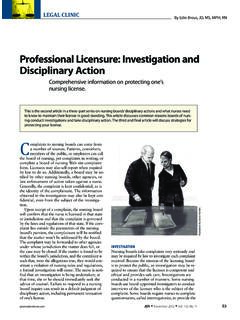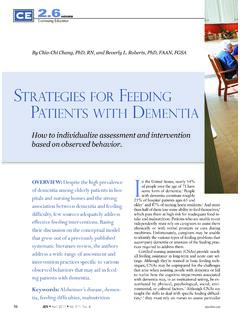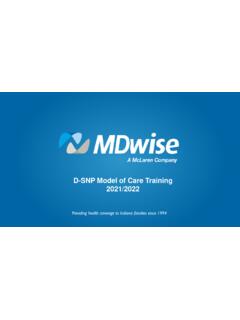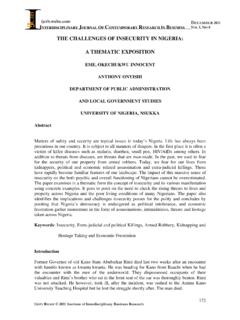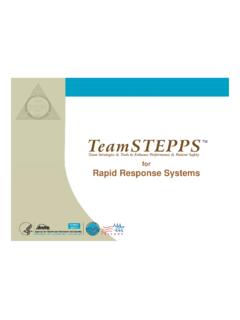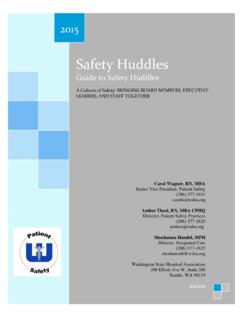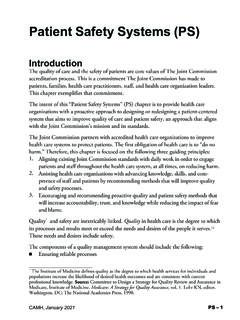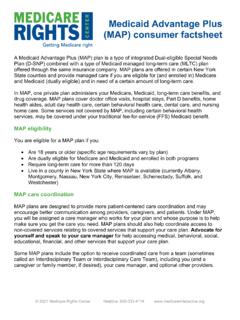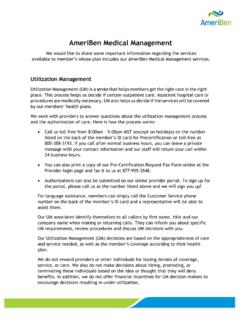Transcription of Using SBAR Communications in Efforts to Prevent Patient ...
1 504 Home Healthcare Nurse Curry Narayan, MSN, RN, HHCNS-BC, HOURSU sing SBAR Communications in Efforts to Prevent Patient RehospitalizationsSituation Background Assessment Recommendation (SBAR) communica-tion has become the standard for communicating across disciplines. It has demonstrated its effectiveness at improving Patient outcomes, enhancing Patient and clinician satisfaction, and helping to control healthcare costs. It can help home healthcare clinicians with Efforts to Prevent avoidable hospi-talizations. But how often and how well do home health clinicians use this method of shared Communications with physicians? This article explores why communication between physicians and home health clinicians can be so problematic. It introduces the SBAR communication method, its origins, its features, and some of the published evidence that it provides effective and efficient communication, thereby promoting better Patient 2013 Lippincott Williams & Wilkins.
2 Unauthorized reproduction of this article is 31 no. 9 October 2013 Home Healthcare Nurse 505reasons interprofessional communication can be so problematic. Several reviews in the medical and nursing literature have explored these com-munication barriers, especially between nurses and physicians. Because of historical and social factors, nurses and physicians have internalized a hierarchical structure for communication and de-cision making in which the physician is in charge (Hall, 2005; Leonard, Graham, & Bonacum, 2004; O Daniel & Rosenstein, 2008; Shannon & Myer, 2012). However, this hierarchical model is not effective in the complex healthcare environment in which no one person can have all the knowl-edge needed for choosing the best course of action (Leonard, Graham, & Bonacum, 2004; Shannon & Myer, 2012).
3 Healthcare has become too complex, each discipline has its own scope of expertise, and suboptimal outcomes occur when important perspectives are not voiced and heard (Leonard, Graham, & Bonacum, 2004; O Daniel & Rosenstein, 2008).In addition, nurse and physician professional education and training have tended to teach two different ways of communicating about Patient issues. Nurses tended to learn to communicate Using a timeline descriptive narrative communi-cation method whereas physicians tended to learn to communicate via prioritized bullet points (Leonard, Graham, & Bonacum, 2004; Shannon & Myer, 2012). Because of this, physicians may have had a tendency to become frustrated with nurses communication styles, subtly feeling the communication style is evidence of a lack of critical thinking.
4 At the same time, many nurses report that they feel too many physicians are inpatient and rude, not valuing their input and insight into patients problems (Leonard, Graham, & Bonacum, 2004).Exploration of nurse decision making about when to call a physician about a Patient problem reveals another barrier to nurse physician com-munication. Nurses are less likely to call a physi-cian if they fear it will result in a psychologically unsafe interaction (Leonard, Graham, & Bonacum, 2004; O Daniel & Rosenstein, 2008). Psychologi-cally unsafe interactions include ones in which the nurse fears anger, insult, or disapproval from the physician or feels that the call won t make a dif-ference because the doctor won t listen to me. For interdisciplinary communication to occur effectively, disciplines need to have a shared way to communicate that works for all the disciplines Communication effectively getting your message across is difficult.
5 The higher the stakes, the more important the message, the more difficult efficient and effective good commu-nication becomes. Consider Sentinel Event statis-tics reported by The Joint Commission (2005, 2013; Tjia et al., 2009). Over the past decade, The Joint Commission has reported the root causes of these events, and approximately 60% to 70% of the sentinel events they examined were related to communication problems. Analysis of the events shows that communication between healthcare team providers frequently was ineffective (did not get the attention deserved) or inadequate (did not include crucial information) resulting in Patient deaths and injury (The Joint Commission, 2005).Effective and appropriate communication is needed in the home healthcare setting as much as it is needed in acute care settings, not only to Prevent sentinel events, but also to Prevent hos-pitalizations and improve Patient outcomes (Quality Insights of Pennsylvania, 2006 ).
6 How-ever, hospitalization rates remain too high and Patient outcomes remain lower than desired. At least some, if not most of these undesirable outcomes, are related to the difficulties and complexities of interdisciplinary team communi-cation, especially with physicians. What we have here is a failure to communicate!This article explores why communication be-tween physicians and home health clinicians can be so problematic. It introduces the Situation Background Assessment Recommendation (SBAR) communication method, its origins, its features, and evidence that it provides effective efficient communication, which can promote bet-ter Patient outcomes. It analyzes each of the SBAR components and provides concrete recom-mendations that home healthcare clinicians can use when preparing to speak with a physician about a Patient problem and how to approach it.
7 Finally, it presents a SBAR template for address-ing a chronic obstructive pulmonary disease (COPD) exacerbation, with the goal of preventing an avoidable hospitalization (Figure 1).Research in interdisciplinary CommunicationResearchers have realized that interprofessional communication or the lack of it has compro-mised Patient safety and have investigated the Copyright 2013 Lippincott Williams & Wilkins. Unauthorized reproduction of this article is Home Healthcare Nurse Template Communication About Exacerbation of COPD SymptomsSituation: Dr. (name), this is (your name, discipline) from (name of your home health agency or hospice). I am calling about ( Patient s name), who is experiencing increased : Patient s age _____ Primary diagnoses: COPD (GOLD stage, if known: A-Mild, B-Moderate, C-Severe, D-Very Severe); other primary/pertinent diagnoses.
8 Recent important events. Examples include: o Admitted to home care on (date) for (reason for home care). o Discharged from the hospital on (date) after being treated for _____. Oxygen use: _____ liters/minute, intermittent or continuous. Current respiratory medications, and frequency of use; recent increased frequency. DNR status if applicable: _____ Have available: medication profile, allergies, and phone number of : (Only report primary/abnormal/pertinent data) Patient s current symptoms: o Dyspnea: Severity on Berg Scale: 1 2 3 4 5 6 7 8 9 10 r Intermittent r Constant o Cough: r Increased frequency r Increased sputum r Increased purulence description o r Fatigue r Restlessness r Anorexia r Difficulty sleeping r Vomiting r Anxious o When did symptoms develop?
9 _____ How severe are symptoms? _____ Physical assessment: Vital signs: Temp _____ Pulse _____ RR _____ BP _____ SaO2 _____ Mental status changes: LOC _____ r Confusion r Anxiety Skin color: r Cyanosis Location: _____ Capillary refill _____ Breathing effort: r Tripod positioning r Pursed lip breathing r Retractions r Nasal flaring Sputum: Color: _____ Consistency: _____ Amount _____ Lung sounds: r Crackles r Wheeze r Diminished Location: _____ Peripheral edema: 1+r 2+r 3+r 4+r Analysis Examples o I believe the Patient has developed a respiratory tract infection. o The Patient s COPD symptoms may have exacerbated because of today s air quality alert. o The Patient s COPD seems to have exacerbated but there are no signs of respiratory : We may be able to avoid hospitalization.
10 We may be able to catch this early .. r Antibiotic: Indicated for increase in dyspnea/sputum volume/sputum purulence. r Systemic corticosteroid: Prednisolone, oral, 30-40 mg, daily for 10-14 days. r Short-acting bronchodilators: r Change route to via nebulizer. r Change frequency to every 4 hours. r Change/add beta-agonist or anticholinergic to_____. r Home oxygen therapy: Titrate to _____ liters/minute to reach oxygen saturation of _____ (88-92%). r Increase visit frequency to _____ (every day x 2-3 days) to monitor treatment plan Interventions: r No exposure to smoke/air pollution r Institute coughing/deep breathing/postural drainage r Force fluids to _____ (2 to 2 quarts) r Teach relaxation and energy conservation techniquesFigure 1. Situation Background Assessment Recommendation (SBAR) communication about exacerbation of chronic obstructive pulmonary disease (COPD) : BP = blood pressure; DNR = do not resuscitate; GOLD = Global Initiative for Obstructive Lung Disease; LOC = level of consciousness; Temp = temperature; RR = respiratory rate; SaO2 = oxygen : 2013 Lippincott Williams & Wilkins.

